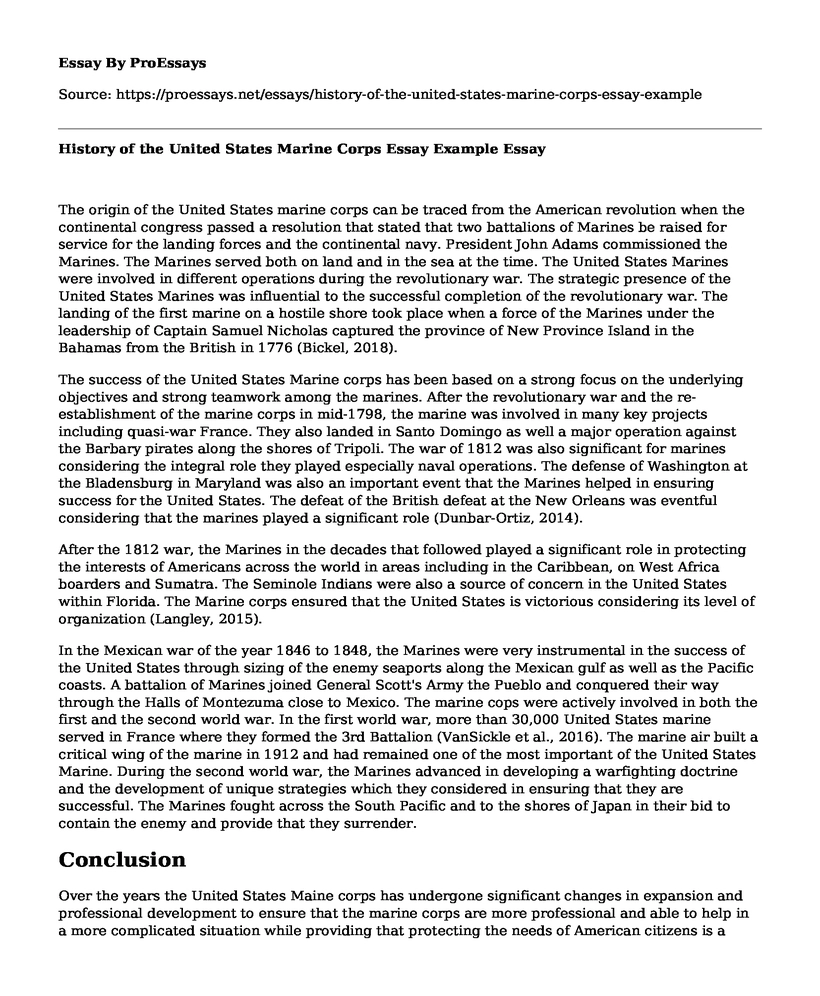The origin of the United States marine corps can be traced from the American revolution when the continental congress passed a resolution that stated that two battalions of Marines be raised for service for the landing forces and the continental navy. President John Adams commissioned the Marines. The Marines served both on land and in the sea at the time. The United States Marines were involved in different operations during the revolutionary war. The strategic presence of the United States Marines was influential to the successful completion of the revolutionary war. The landing of the first marine on a hostile shore took place when a force of the Marines under the leadership of Captain Samuel Nicholas captured the province of New Province Island in the Bahamas from the British in 1776 (Bickel, 2018).
The success of the United States Marine corps has been based on a strong focus on the underlying objectives and strong teamwork among the marines. After the revolutionary war and the re-establishment of the marine corps in mid-1798, the marine was involved in many key projects including quasi-war France. They also landed in Santo Domingo as well a major operation against the Barbary pirates along the shores of Tripoli. The war of 1812 was also significant for marines considering the integral role they played especially naval operations. The defense of Washington at the Bladensburg in Maryland was also an important event that the Marines helped in ensuring success for the United States. The defeat of the British defeat at the New Orleans was eventful considering that the marines played a significant role (Dunbar-Ortiz, 2014).
After the 1812 war, the Marines in the decades that followed played a significant role in protecting the interests of Americans across the world in areas including in the Caribbean, on West Africa boarders and Sumatra. The Seminole Indians were also a source of concern in the United States within Florida. The Marine corps ensured that the United States is victorious considering its level of organization (Langley, 2015).
In the Mexican war of the year 1846 to 1848, the Marines were very instrumental in the success of the United States through sizing of the enemy seaports along the Mexican gulf as well as the Pacific coasts. A battalion of Marines joined General Scott's Army the Pueblo and conquered their way through the Halls of Montezuma close to Mexico. The marine cops were actively involved in both the first and the second world war. In the first world war, more than 30,000 United States marine served in France where they formed the 3rd Battalion (VanSickle et al., 2016). The marine air built a critical wing of the marine in 1912 and had remained one of the most important of the United States Marine. During the second world war, the Marines advanced in developing a warfighting doctrine and the development of unique strategies which they considered in ensuring that they are successful. The Marines fought across the South Pacific and to the shores of Japan in their bid to contain the enemy and provide that they surrender.
Conclusion
Over the years the United States Maine corps has undergone significant changes in expansion and professional development to ensure that the marine corps are more professional and able to help in a more complicated situation while providing that protecting the needs of American citizens is a priority. The Marine has continued with its tradition in embracing innovation to overcome challenges of the century. The Marine corps war laboratory developed in 1995 has remained as a technological nerve center for the Marines where they have sought to create fundamental technology-based war techniques to overcome their enemies. Therefore, maintaining the legacy of the past United States marine corps have formed the basis of the current changes (Langley, 2015).
References
Bickel, K. B. (2018). Mars Learning: The Marine Corps' development of small wars doctrine, 1915-1940. Routledge.
Dunbar-Ortiz, R. (2014). An indigenous peoples' history of the United States (Vol. 3). Beacon Press.
Langley, H. (2015). Social Reform in the United States Navy, 1798-1862. Naval Institute Press.
VanSickle, M., Werbel, A., Perera, K., Pak, K., DeYoung, K., & Ghahramanlou-Holloway, M. (2016). Perceived barriers to seeking mental health care among the United States Marine Corps noncommissioned officers serving as gatekeepers for suicide prevention. Psychological assessment, 28(8), 1020.
Cite this page
History of the United States Marine Corps Essay Example. (2022, Aug 23). Retrieved from https://proessays.net/essays/history-of-the-united-states-marine-corps-essay-example
If you are the original author of this essay and no longer wish to have it published on the ProEssays website, please click below to request its removal:
- China Expereincing Renewed Pressure
- Essay Sample on Chinese Characters and System of Writing
- Research Paper on The Red Guards
- Paper Example on Canadian Inequality
- History of Mexico and Anglo Expansion Essays
- Should Mexico Be Blamed? Immigration in America and Its Policy Essay
- U.S. Pharmaceutical Price Reductions: R&D, Reimbursement, & Determinants - Essay Sample







